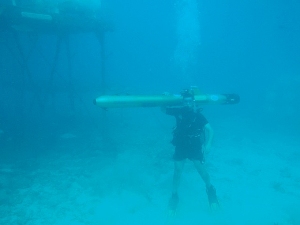The Extreme Environment Mission Operations project, by NASA was conducted at the Aquarius Underwater Laboratory, situated at a distance of 3.5 miles off Key Largo. NASA sent teams, early this month, to the underwater lab in an attempt to get ready for a simulated asteroid mission in October.
 UD’s autonomous underwater vehicle
UD’s autonomous underwater vehicle
The assistant professor of geological sciences of University of Delaware (UD), Art Trembanis, stated that an underwater environment presents a situation, which is similar to what astronauts will face including weightlessness, food and supplies, communication, and life support.
The research team deployed UD’s autonomous underwater vehicle (AUV) from a surface vessel. The AUV was used to collect various types of vital underwater data by incorporating sonar sensors, cameras and other devices.
The objective of the mission was to determine the baseline mapping of the region. In addition, it was possible to establish the appearance of the terrain, its composition, the type of resources available and the environmental factors. Depending on the data obtained, NASA professionals who are planning the simulation mission can determine the type of wetsuits required or the location where an obstacle needs to be placed to help astronauts hone their space walking skills.
The robot gathered information about water quality factors such as temperature, salinity and dissolved oxygen by traveling a distance of 62 miles. It has also captured 85,000 images and HD videos extending over 12 hours.